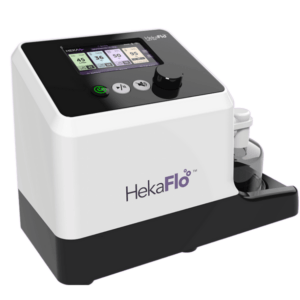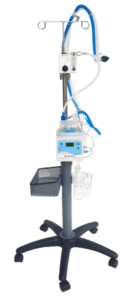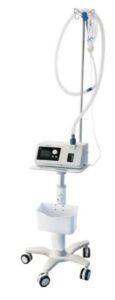Welcome to our blog where we delve into the fascinating world of High Flow Nasal Cannula (HFNC) Systems. As a revolutionary technology in respiratory support, it is crucial to understand its working principle and the benefits it offers. By improving oxygenation and providing effective respiratory support, the HFNC System has become a game-changer in healthcare. In this section, we will explore the fundamental aspects of the HFNC System, providing valuable insights that will enhance your understanding of this innovative technology.
Exploring the Advantages of High Flow Nasal Cannula (HFNC) System
The advantages of the High Flow Nasal Cannula (HFNC) System are numerous and impactful. This advanced system delivers precise oxygenation, ensuring that patients receive the optimal amount of oxygen they need. By reducing the work of breathing, the HFNC System eases the strain on the respiratory system, enhancing patient comfort and compliance. Moreover, it provides a controlled flow of heated and humidified air, which is vital for patients with respiratory distress or chronic lung conditions. The HFNC System not only improves oxygenation efficiency but also minimizes the risks associated with high or low oxygen levels. Its versatility and benefits make it a preferred choice in various clinical settings.
One of the key advantages of the HFNC System is its ability to deliver high flow rates, which promotes better oxygenation and reduces the need for invasive ventilation methods. This is particularly beneficial for patients with acute respiratory failure or those who require respiratory support after extubation. The HFNC System also provides a more comfortable respiratory support experience compared to other oxygen delivery methods. It’s heated and humidified air reduces dryness and discomfort in the airways, enhancing patient satisfaction and compliance.
Another advantage of the HFNC System is its ability to provide consistent oxygen concentration. Unlike other oxygen therapy methods, which may result in inconsistent oxygen levels due to variations in breathing patterns, the HFNC System ensures a stable and accurate delivery of oxygen. This is especially critical in patients with conditions such as chronic obstructive pulmonary disease (COPD) or respiratory distress, where maintaining appropriate oxygenation levels is crucial for their well-being.
Furthermore, the HFNC System offers the advantage of reducing the work of breathing. Providing a high flow of heated and humidified air decreases the effort required for inhalation and exhalation. This is particularly beneficial for patients with respiratory muscle fatigue or those with conditions that cause increased work of breathing, such as acute respiratory distress syndrome (ARDS). The reduced work of breathing not only improves patient comfort but also conserves energy, allowing patients to better cope with their respiratory condition and facilitating the healing process.
In summary, the advantages of the High Flow Nasal Cannula (HFNC) System are substantial. From precise oxygenation delivery to enhanced patient comfort and reduced work of breathing, this innovative technology has transformed respiratory support in healthcare. Its versatility and ability to improve outcomes make it an invaluable tool in various clinical settings.
A Practical Guide to High Flow Nasal Cannula (HFNC) System
Using the High Flow Nasal Cannula (HFNC) System requires a thorough understanding of its setup, fitting, and monitoring procedures. This practical guide will walk you through each step, ensuring that you can confidently provide effective respiratory support to your patients. From assembling the device to adjusting the flow rates and monitoring patient responses, this blog covers everything you need to know to maximize the benefits of the HFNC System. By following these guidelines, you can ensure optimal patient care and treatment outcomes.
To begin, let’s explore the initial setup of the HFNC System. It is important to ensure that the device is clean and in proper working condition before use. The blog will provide step-by-step instructions on how to assemble the system, including attaching the nasal cannula and connecting the oxygen source. Proper assembly is crucial to ensure the system functions effectively and delivers the desired therapy.
Once the HFNC System is set up, the next step is to fit it properly to the patient. Proper fitting ensures that the system delivers the intended flow rates and provides optimal oxygenation. The blog will explain the key considerations for fitting the nasal cannula, including choosing the appropriate size and positioning it correctly in the patient’s nostrils. A well-fitted nasal cannula maximizes the effectiveness of the therapy and enhances patient comfort.
Monitoring the patient’s response to the HFNC System is essential for adjusting the flow rates and assessing treatment efficacy. The blog will provide insights into the key parameters to monitor, such as oxygen saturation levels, respiratory rate, and patient comfort. Understanding how to interpret these measurements and make necessary adjustments ensures that the therapy remains effective throughout the patient’s treatment.
In addition to the technical aspects of using the HFNC System, the blog will also cover important considerations related to patient safety and infection control. It will provide recommendations on maintaining a clean environment, proper hygiene practices, and regular equipment maintenance. These measures not only safeguard the patient’s well-being but also ensure the longevity and optimal performance of the HFNC System.
By following this practical guide, healthcare providers can confidently use the High Flow Nasal Cannula (HFNC) System to provide effective respiratory support to their patients. The step-by-step instructions, along with insights into monitoring and maintenance, will equip you with the knowledge and skills needed to deliver optimal care and achieve the desired therapeutic outcomes.
Exploring the Clinical Applications of High Flow Nasal Cannula (HFNC) System
The High Flow Nasal Cannula (HFNC) System has revolutionized respiratory care by offering a wide range of clinical applications. In this section, we will explore how the HFNC System is utilized in different scenarios, such as respiratory distress, post-extubation support, and acute respiratory failure.
Respiratory distress is a common condition where the HFNC System has proven to be highly effective. It provides a non-invasive alternative to invasive ventilation methods, such as intubation, while delivering a high flow of heated and humidified oxygenated air. This helps to alleviate the symptoms of respiratory distress and improve oxygenation. The HFNC System can be used as a first-line therapy or as a bridge to more invasive interventions if needed.
Post-extubation support is another important application of the HFNC System. After being removed from mechanical ventilation, patients may still require respiratory support to facilitate a smooth transition to independent breathing. The HFNC System offers an effective solution by providing continuous positive airway pressure (CPAP) and supplemental oxygen, reducing the risk of respiratory failure and the need for reintubation. It also helps to optimize lung recruitment and enhance oxygenation, promoting faster recovery.
Acute respiratory failure is a critical condition where the HFNC System plays a vital role. By delivering a high flow of oxygenated air, it improves oxygenation and reduces the work of breathing in patients with compromised lung function. The HFNC System can be particularly beneficial in conditions such as acute respiratory distress syndrome (ARDS), pneumonia, or chronic obstructive pulmonary disease (COPD) exacerbations. It allows for better patient comfort, while also providing the necessary respiratory support to improve outcomes.
Moreover, the HFNC System has found applications beyond the traditional hospital setting. It can be used during the transportation of critically ill patients, both within the hospital and during inter-hospital transfers. Its portability and ease of use make it a valuable tool in ensuring continuous respiratory support during these critical moments.
In summary, the High Flow Nasal Cannula (HFNC) System has diverse clinical applications, ranging from respiratory distress to post-extubation support and acute respiratory failure. Its ability to deliver a high flow of heated and humidified oxygenated air makes it a versatile and effective therapeutic option in various clinical scenarios. Healthcare providers can utilize the HFNC System to improve patient outcomes, enhance comfort, and potentially avoid more invasive interventions.
Enhancing Patient Comfort with High Flow Nasal Cannula (HFNC) System
Patient comfort is a crucial aspect of healthcare, and the High Flow Nasal Cannula (HFNC) System excels in providing a comfortable respiratory support experience. In this section, we will explore how the HFNC System enhances patient comfort by focusing on improved oxygenation and reduced discomfort.
One of the key factors that contribute to patient comfort with the HFNC System is its ability to deliver a high flow of heated and humidified air. This feature addresses one of the common issues with traditional oxygen therapy methods, such as nasal cannulas or face masks, which can cause dryness and discomfort in the respiratory tract. The HFNC System’s heated and humidified air helps to alleviate these problems by maintaining optimal moisture levels, resulting in a more comfortable breathing experience for patients.
Additionally, the HFNC System reduces the work of breathing, which can greatly enhance patient comfort, especially for individuals with respiratory distress or compromised lung function. By delivering a high flow of oxygenated air, the system helps to alleviate the effort required for inhalation and exhalation. This reduction in respiratory effort not only minimizes discomfort but also conserves energy, allowing patients to rest more comfortably and promote healing.
The precise oxygenation delivery provided by the HFNC System also contributes to patient comfort. Oxygen is a vital component for the body’s overall functioning, and inadequate oxygenation can lead to fatigue, shortness of breath, and other discomforting symptoms. The HFNC System ensures that patients receive the optimal amount of oxygen they need, promoting better overall well-being and reducing the discomfort associated with low oxygen levels.
Moreover, the HFNC System’s design offers a lightweight and less restrictive alternative to traditional respiratory support methods. Patients can enjoy greater freedom of movement, allowing them to sit up, change positions, and engage in activities that improve their overall comfort and well-being. The nasal cannula design of the HFNC System is less obtrusive compared to face masks or endotracheal tubes, further enhancing patient comfort and compliance.
In summary, the High Flow Nasal Cannula (HFNC) System excels in enhancing patient comfort during respiratory support. By delivering a high flow of heated and humidified air, reducing the work of breathing, and providing precise oxygenation, the system creates a more comfortable respiratory experience for patients. This improved comfort can positively impact patient compliance, well-being, and overall treatment outcomes.
Cleaning and Maintaining Your High Flow Nasal Cannula (HFNC) System
Proper cleaning and maintenance of the High Flow Nasal Cannula (HFNC) System are crucial to ensure its optimal performance, longevity, and patient safety. In this section, we will provide a step-by-step guide on how to clean and maintain your HFNC System, including device upkeep, infection control, and equipment lifespan.
Regular cleaning of the HFNC System is essential to prevent the buildup of dirt, dust, or pathogens that can compromise its performance and patient safety. The blog will provide detailed instructions on how to disassemble the system for cleaning, including the nasal cannula, tubing, and any other removable components. It will also recommend appropriate cleaning solutions and techniques to ensure effective disinfection.
In addition to routine cleaning, the HFNC System requires periodic maintenance to keep it in optimal working condition. The blog will outline maintenance tasks such as inspecting for wear and tear, checking for leaks, and replacing worn-out or damaged parts. These maintenance activities help identify and address any potential issues before they impact the system’s performance or patient care.
Proper infection control practices are paramount when using the HFNC System. The blog will provide guidelines on how to minimize the risk of contamination, including hand hygiene, disinfection protocols, and the use of disposable or single-patient use components whenever possible. Following these infection control measures reduces the chances of transmitting infections and ensures patient safety.
Furthermore, the blog will include recommendations on prolonging the lifespan of the HFNC System. It will cover best practices for storage, handling, and transportation to prevent damage and maintain the system’s integrity. By following these guidelines, healthcare providers can maximize the value of their investment and minimize the need for frequent equipment replacement.
In summary, proper cleaning and maintenance of the High Flow Nasal Cannula (HFNC) System are essential for optimal performance, infection control, and patient safety. By adhering to the step-by-step guide for device cleaning, maintenance, and lifespan extension, healthcare providers can ensure that their HFNC System remains in excellent condition and continues to deliver effective respiratory support to patients.
High Flow Nasal Cannula (HFNC) System from Leading Indian Manufacturers
BM-HFNC-11
The BM-HFNC-11 is a high-quality medical device manufactured and supplied by Bird Meditech in India. This versatile device functions as both a CPAP machine and a high-flow nasal cannula (HFNC) therapy system. With its advanced capabilities, it provides crucial respiratory support for patients with severe cases of coronavirus pneumonia and other respiratory conditions.
One of the key features of the BM-HFNC-11 is its wide oxygen concentration range, spanning from 21% to 100%. This allows healthcare providers to precisely adjust the oxygen levels based on each patient’s requirements. The device is designed to meet a FiO2 accuracy of ±3%, ensuring accurate and reliable oxygen delivery.
Operating with a gas source, the BM-HFNC-11 has an inlet gas supply pressure ranging from 0.35 to 0.45 MPa (50 to 65 PSI). This ensures a steady and consistent flow of oxygen to patients. Additionally, the device is equipped with a bleeping alarm system that provides notifications for important events or changes in the treatment.
The outlet flow of the BM-HFNC-11 can be adjusted within a range of 2 to 120 liters per minute (LPM). This flexibility allows healthcare professionals to tailor the treatment to the specific needs of each patient. Moreover, the device includes an auxiliary outlet flow range of 2 to 120 LPM, further enhancing its versatility and usability.
To ensure accuracy and reliability, the BM-HFNC-11 utilizes NIST gas inlet fittings. These fittings meet the stringent standards set by the National Institute of Standards and Technology, guaranteeing precise and consistent gas delivery.
HekaFlo
HekaFlo, manufactured by Heka Medicals India Pvt. Ltd., is a cutting-edge High Flow Nasal Cannula (HFNC) system designed to provide optimal respiratory support to patients. As one of the leading manufacturers and global suppliers of HFNC systems in India, Heka Medicals takes pride in offering innovative solutions to meet the critical needs of patients.
The HekaFlo HFNC system delivers 100% humidified and heated oxygen at a flow rate of up to 60 liters per minute. This advanced therapy is specifically designed for hypoxic patients who are able to breathe spontaneously. It has proven highly effective in managing respiratory distress caused by hypoxemia in patients with COVID-19 infection.
Compared to traditional oxygen therapy, HekaFlo’s high-flow oxygen therapy can provide flow rates of up to 60 liters per minute, offering significant advantages. By delivering heated and humidified gas, the system ensures patient comfort and minimizes the risk of mucosal injury associated with high flow rates.
The HekaFlo HFNC system boasts a user-friendly design with a large touchscreen interface and quick setup functionality. It features an electronic air and O2 blender, providing precise control over the oxygen concentration. The intuitive graphical user interface (GUI) makes it easy for healthcare professionals to operate the system.
Safety and patient comfort are paramount considerations for HekaFlo. The system incorporates an ultra-quiet blower, ensuring a quiet and peaceful environment for patients. It includes built-in system alerts to facilitate proactive monitoring and address any potential issues promptly. The ergonomic and soft cannula design enhances patient comfort during treatment.
Oxyflow 505
Neokraft Medical Private Limited, a leading manufacturer and global supplier based in India, presents the Oxyflow 505 High Flow Nasal Cannula (HFNC) system. This innovative device is designed to deliver hot and humidified oxygen, thereby increasing the humidity and temperature of the trachea. The Oxyflow-505 is a versatile solution that can effectively treat patients of all ages with acute respiratory failure.
One of the key advantages of the Oxyflow 505 is its ability to moisturize and heat the delivered oxygen, which aids in the removal of secretions from the airways. This feature is particularly beneficial in patients who require enhanced airway clearance. By optimizing the humidity and temperature of the oxygen, the Oxyflow 505 promotes a more favorable environment for effective secretion clearance.
In addition, the Oxyflow 505 introduces positive airway pressure, which helps to wash out the dead space present in the upper part of the airway. This mechanism facilitates the removal of stale air and improves ventilation efficiency. By maintaining a continuous flow of oxygen, the Oxyflow 505 promotes optimal respiratory function and supports patients with acute respiratory failure.
The Oxyflow 505 system enables the delivery of 100% oxygen when necessary, ensuring prompt and efficient treatment for patients experiencing hypoxemia. The device is equipped with a FiO2 monitor that allows healthcare providers to accurately monitor and adjust the oxygen concentration according to individual patient needs. This feature ensures precise oxygen delivery and enhances the effectiveness of the therapy.
Patient comfort is a top priority for Oxyflow 505. The device is designed to provide a comfortable user experience and does not hinder the patient’s ability to speak or eat. Patients can communicate effectively and maintain their daily activities while receiving the necessary respiratory support.
H – 80M High Flow Nasal Cannula Oxygen Therapy
Silverline Meditech Pvt. Ltd., a prominent medical device manufacturer based in India, presents the H-80M High Flow Nasal Cannula Oxygen Therapy system. This advanced device is specifically designed to provide high-flow nasal cannula (HFNC) oxygen therapy for a wide range of respiratory conditions, including respiratory failure, COPD, COVID-19, infants, pneumonia, asthma, bronchitis, sleep apnea, lung disease, and emphysema.
The H-80M features an innovative dual turbine design, allowing for precise control of oxygen flow rates. With a dedicated low and high flow mode, ranging from 2 LPM (liters per minute) to 80 LPM, healthcare providers can tailor the therapy to meet individual patient needs. This versatility ensures effective oxygenation and respiratory support across various clinical scenarios.
To enhance patient comfort, the H-80M is equipped with an integrated heated humidifier. The humidifier offers a wide range of temperature control, ensuring optimal humidity levels for patient comfort and respiratory function. Additionally, the device incorporates an auto-feeding humidifier chamber, which eliminates the need for frequent refilling, streamlining the therapy process and improving patient experience.
The H-80M boasts several features that contribute to its user-friendly design. Its disinfection-free design includes a backflow prevention valve, promoting infection control and ensuring patient safety. Real-time monitoring is made convenient with a 3.5-inch color LCD display, providing healthcare providers with essential information on FiO2 (fraction of inspired oxygen), temperature, and flow rates. The device also offers a humidity compensation function, which automatically adjusts for different environmental conditions, maintaining optimal humidity levels for the patient’s respiratory comfort.
Annuflow-HC
Kyron Healthcare Pvt. Ltd., a leading medical device manufacturer based in India, presents the Annuflow-HC High Flow Nasal Cannula (HFNC) System and CPAP system. Designed for ease of use and versatility, the Annuflow-HC is a reliable respiratory support solution for spontaneously breathing patients in both adult and pediatric settings.
The Annuflow-HC features a user-friendly fully touch interface, allowing healthcare providers to easily navigate and adjust settings. With real-time oxygen concentration display, clinicians can accurately monitor and adjust the FiO2 (fraction of inspired oxygen) levels to meet individual patient requirements. This ensures optimal oxygenation and respiratory support.
Maintaining the ideal humidity levels is crucial for patient comfort and respiratory function. The Annuflow-HC excels in delivering optimal humidity with a temperature range of 31 to 41℃. This feature helps prevent dryness and discomfort in the airways, promoting better tolerance and adherence to therapy.
The device offers a wide range of flow rates, from 4 to 80 LPM (liters per minute). This flexibility allows healthcare providers to customize the therapy based on patient needs, ensuring precise and effective respiratory support. Whether it is low flow requirements for pediatric patients or high flow rates for adults, the Annuflow-HC delivers reliable and adjustable airflow.
Safety and patient monitoring is paramount in respiratory support systems. The Annuflow-HC is equipped with an enhanced alarm system that provides timely notifications and alerts. These alarms help healthcare providers respond promptly to any deviations from the desired settings, ensuring patient safety and effective therapy delivery.
Medzell: Empowering Medical Device Promotion in Emerging Markets
Medzell is a cutting-edge B2B platform designed to promote Indian medical devices in emerging markets. With its futuristic approach and comprehensive network, Medzell provides a valuable opportunity for medical device manufacturers to expand their reach and connect with healthcare providers worldwide.
As a trusted platform, Medzell offers a curated selection of high-quality medical devices, including the High Flow Nasal Cannula (HFNC) system. Manufacturers can showcase their products on Medzell, leveraging its extensive user base and targeted marketing strategies to reach potential buyers in emerging markets.
With a focus on promoting Indian medical devices, Medzell bridges the gap between manufacturers and healthcare providers, ensuring that innovative and reliable products like the HFNC system are accessible to those who need them the most. By providing a centralized platform for product listings, information, and seamless transactions, Medzell streamlines the process of medical device procurement and distribution.
Moreover, Medzell offers valuable resources and educational content to healthcare professionals, enabling them to make informed decisions about the adoption and implementation of the HFNC system. Through product demonstrations and detailed product information, Medzell ensures that healthcare providers have access to the latest advancements and best practices in respiratory care.







